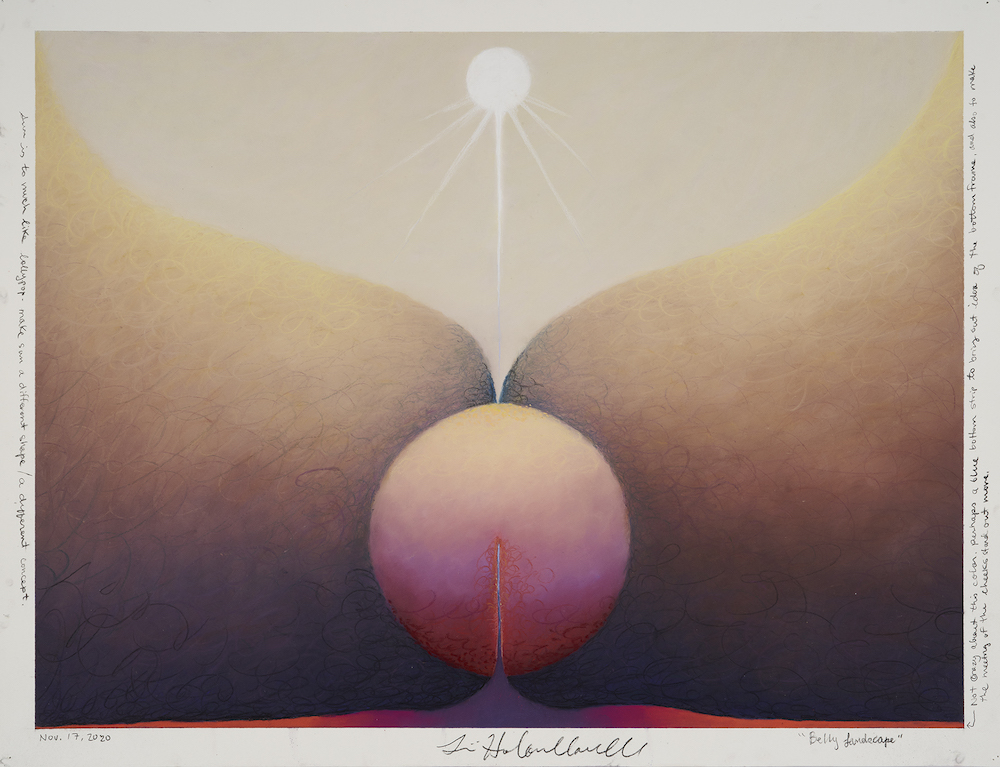Manetti Shrem Museum, UC Davis // September 25, 2022 – May 08, 2023
 Belly Landscape, November 17, 2020. Soft pastel on paper, 20 x 26 in. © Loie Hollowell. Courtesy of Pace Gallery. Photo: Melissa Goodwin.
Belly Landscape, November 17, 2020. Soft pastel on paper, 20 x 26 in. © Loie Hollowell. Courtesy of Pace Gallery. Photo: Melissa Goodwin.
 Belly, breast…, August 23, 2021. Soft pastel on paper, 25.5 x 22 in. © Loie Hollowell. Courtesy of Pace Gallery. Photo: Melissa Goodwin.
Belly, breast…, August 23, 2021. Soft pastel on paper, 25.5 x 22 in. © Loie Hollowell. Courtesy of Pace Gallery. Photo: Melissa Goodwin.
 Empty Belly, September 8, 2021. Soft pastel on paper, 36 x 48 in. © Loie Hollowell. Courtesy of Pace Gallery. Photo: Melissa Goodwin.
Empty Belly, September 8, 2021. Soft pastel on paper, 36 x 48 in. © Loie Hollowell. Courtesy of Pace Gallery. Photo: Melissa Goodwin.
 Finding Time, September 29, 2021. Soft pastel on paper, 36 x 50 in. © Loie Hollowell. Courtesy of Pace Gallery. Photo: Melissa Goodwin.
Finding Time, September 29, 2021. Soft pastel on paper, 36 x 50 in. © Loie Hollowell. Courtesy of Pace Gallery. Photo: Melissa Goodwin.
 Four breasts in pink-purple, red, and yellow, January 6, 2021. Soft pastel on paper, 20 x 20”. © Loie Hollowell. Courtesy of Pace Gallery. Photo: Melissa Goodwin.
Four breasts in pink-purple, red, and yellow, January 6, 2021. Soft pastel on paper, 20 x 20”. © Loie Hollowell. Courtesy of Pace Gallery. Photo: Melissa Goodwin.
“It starts with trying… to make these sexual graphic cartoony sketches in my notebook, then abstracting that and making it more geometric, more abstract,” Loie Hollowell told Juxtapoz a few years ago. “I don’t know, I’m not an art historian, and I can’t give a long description of what the history of abstraction is, but for me, these works are portraits of certain experiences.” That is a revealing explanation from the artist, that even in these paintings that she finalizes, the body parts and sexuality aren’t some sort of Magic Eye scenario. These shapes become more and more clear that there is something physical, almost direct in their representation.
The rising star of contemporary art, with representation by the hallowed Pace Gallery and exhibitions around the world, turns to drawing in Tick Tock Belly Clock at the Manetti Shrem Museum. That curatorial choice gives an intimate overview of all her output. The works here, created entirely during the pandemic, is a reminder that the act of drawing is at the heart of any artist’s career. A bit of a homecoming show, with Hollowell’s father, David, a long-time UC David Professor Emeritus, and childhood in nearby Woodland, California, that sort of intimacy of work and place seems vital. Works on paper are often treated as afterthoughts, or too primitive for a showcase of such importance, but artists often use paper as both the basis for grander outputs but also as their brainstorming sessions. To see such an artist, with elaborate depth in her paintings, turn to paper is both exciting and pivotal in understanding how she has become such a force in art. —Evan Pricco
Check out some of our recent short videos:









